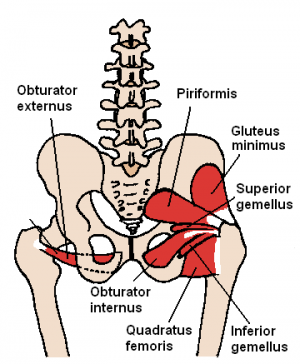Description
Piriformis is a flat muscle and the most superficial muscle of the deep gluteal muscles. It is part of the lateral rotators of the hip (obturator internus, superior and inferior gemelli, quadratus femoris, obturator externus, and [1] It has a pyramidal shape that lies almost parallel with the posterior margin of the
Anatomy[1]
Origin
- Anterior aspect of the sacrum at the level of about S2 through S4
- Sacrotuberous ligament
- Periphery of the greater sciatic notch
Insertion
- Superior and medial aspects of the greater trochanter.
Nerve
Artery
- The arterial supply is from the inferior gluteal, superior gluteal and internal pudendal arteries, all branches of the internal iliac artery[2].
Function[1][3]
- Lateral Rotation of the hip when it is extended (that is when in standing).
- Abduction of the hip when it is flexed.
- Aids slightly in tilting pelvis laterally.
- Also aids in tilting pelvis posteriorly by pulling the sacrum down towards the thigh[4].
Clinical relevance
The piriformis muscle can be used to locate the sciatic nerve. This nerve enters the gluteal region inferiorly to the piriformis. If the lateral rotators of the hip are tight they may exert pressure on the sciatic nerve, producing pain radiating into the lower extremity.[1][5] This is known as [5]
Assessment
Palpation
It may be palpable indirectly through the gluteus maximus into the greater sciatic notch.
Test
Treatment
Strengthening
Stretching
Manual techniques
References


